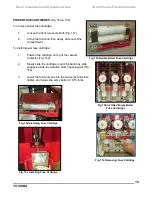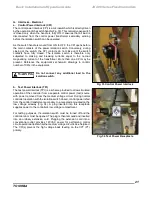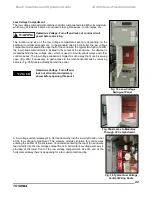
Basic Installation and Operation Guide
JK 400 Series Fixed Controllers
TOSHIBA
9
Incoming Line
On the
standard JK, incoming power cable connections should
be made at the points shown on the wiring diagram furnished
with the equipment.
These connections will normally be made in
a separate incoming compartment to bus lugs, an incoming load
interrupter switch, or a vacuum circuit breaker. If the equipment is
a single controller (e.g. 1-
High, JKSSS, RVAT) and no incoming
section is provided, the incoming main power terminations are in
the rear bus compartment (Fig. 13), behin
d the low voltage
compartment swing out panel. The terminations can be accessed
through this compartment or by removing the enclosure rear cover.
The bottom incoming cable entrance location is also shown in
Figure 13.
Load Connections
Outgoing load connections are made in the controller
compartment to the three lugs or copper pads located as shown in
Figure 14
a and 14b.
Fig. 13 Single Controller Incoming Wiring,
Bottom Entry
Load cable termination arrangements for
certain controllers, such as reduced voltage
autotransformer and solid state types, may
differ from those shown in this manual. In
these cases, refer to the drawings furnished
with the equipment.
To access cable termination areas, remove
fuse barriers as shown in
Fig. 45,
then
remove fuses (see Power Fuse
s section).
After completing the cable termination and
re-installation of the fuses, re-install the four
vertical and one angle shaped horizontal
fuse barriers and position them per
Fig. 45
and 46.
Failure to properly
install fuse barriers
can result in major
equipment damage
and possible
personnel injury.
Fig. 14a Controller Load Wiring Fig. 14b Controller Load Wiring
Bar Type CTs
Window Type CTs
When routing and terminating load cables, observe the following:
- Use listed compression connectors suitable for the cable being used.
- Use the 1/2" hardware provided with the controller to attach cable connectors to bus pads. After installation,
torque hardware to 45 ft-lbs.
- After installation, check to see that the minimum clearance (per NEC) is maintained between live parts and
between live parts and ground.
WARNING
















































